|
|
Post by oldcyansilverback on May 27, 2022 6:02:49 GMT -5
 Somebody made this size comparison between Chamlid and the tigress. The male Ussuri brown bear seems to be twice the weight of that tigress. Therefore, he might be less than twice the weight of the bespectacled male tiger. |
|
|
|
Post by Gorilla king on May 27, 2022 7:50:30 GMT -5
Reply #360, that tigress got lucky that bear only wanted her food, she is a good hunter.
|
|
|
|
Post by oldcyansilverback on May 27, 2022 8:21:33 GMT -5
A Dance of Death: Tigers and Bears Battle in Northeast Asia.By John Goodrich, Ph.D. Chief Scientist; Director, Tiger Program 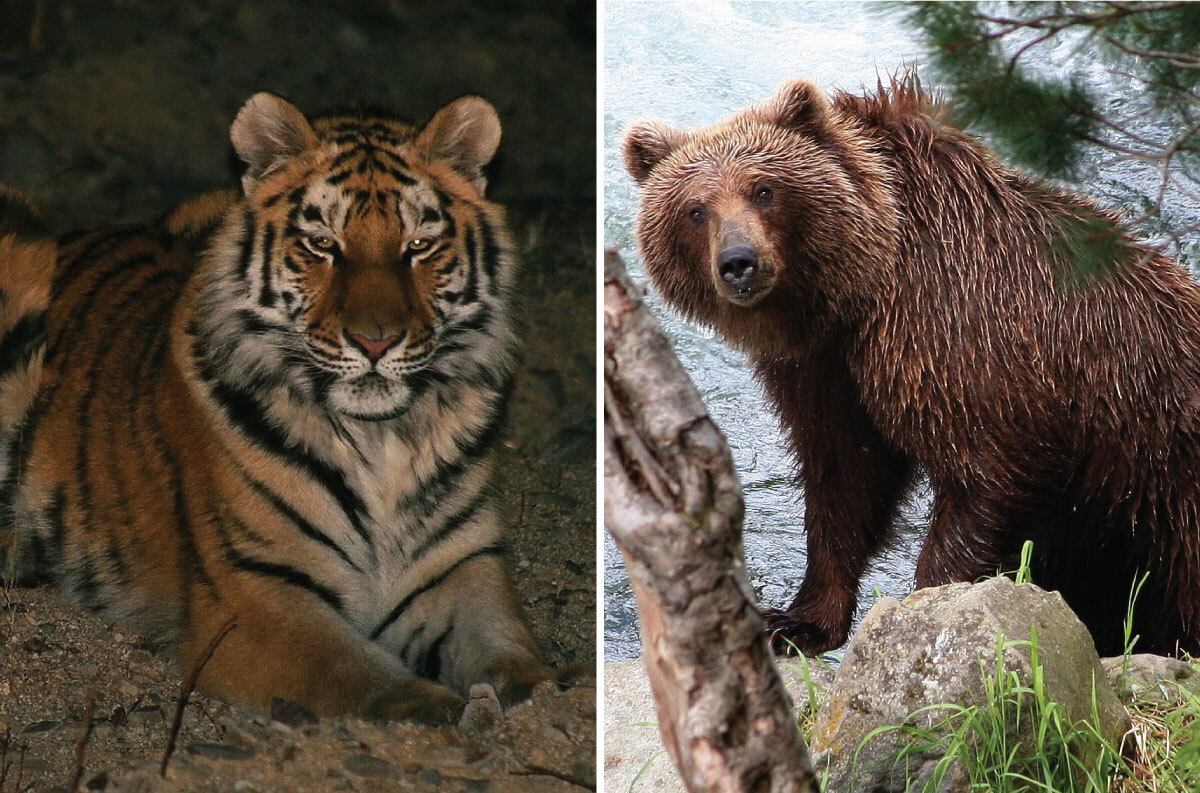 In this blog, Panthera Tiger Program Director Dr. John Goodrich transports us to the snowy regions of northeast Asia — the home of wolves, bears, leopards and Siberian tigers. After stumbling upon a shocking tiger kill, he recounts how he began to understand the complex relationship between tigers and bears in this challenging environment. Navigate the snowy oak forests with Dr. Goodrich as he brings to light the important conservation implications of these interactions. A few decades ago, when I lived and worked in northeast Asia, I was tracking a male tiger named Dima that we had captured and fitted with a radio collar a few months before. He was the biggest tiger we would catch in 20 years of research in the area, and at 455 lbs, the circumference of his head was bigger than my waist and the base of his tail was as thick as my thigh. He had been moving through an area where people had summer gardens and grazed cattle, so I was having a look around to make sure he wasn’t getting himself into trouble. But what I found that day blew my mind. I followed his tracks in light patches of early spring snow. Here — we saw he meandered through a park-like oak forest. And there — suddenly, as he approached the edge of a steep embankment, his tracks became spaced very close together. He crouched into a stalk. And when I looked over the embankment, I was shocked. Before me was a large, partially-eaten brown bear sow. 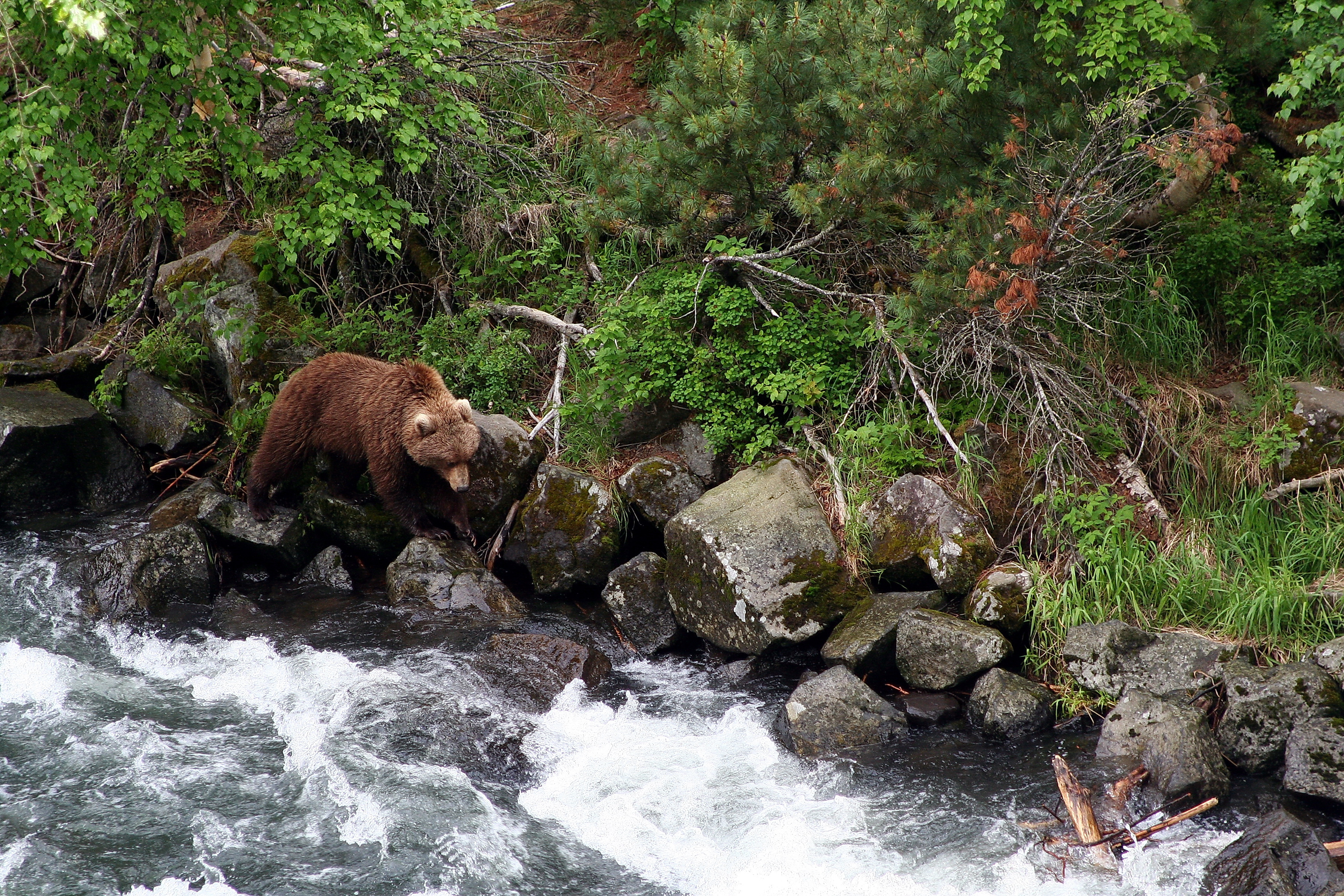 I jumped down to examine the carcass and immediately noted a single, bloody hole in her neck that was clearly an entry wound. Her tracks showed that she had ambled along the base of the embankment and seemed to suddenly fall down dead, with no sign of the struggle one would expect from a huge tiger killing a bear nearly his own size. I concluded the bear had been shot and Dima just took advantage of a free meal, but why hadn’t the hunter claimed such a valuable prize? Then I turned the bear over to inspect the exit would. To my surprise, I found two more entry wounds! I revised my conclusion — Dima had leapt from the bank onto the bear, dispatching her with a single bite to the nape of her neck, almost before she was even aware of his presence (one of his canine teeth had broken prior to our capturing him, hence only three bite wounds). The power and skill required to do that was unimaginable. I collected some samples and vacated the area, hoping Dima would return to finish his meal, which he did, though it took him several days to devour such a large animal. 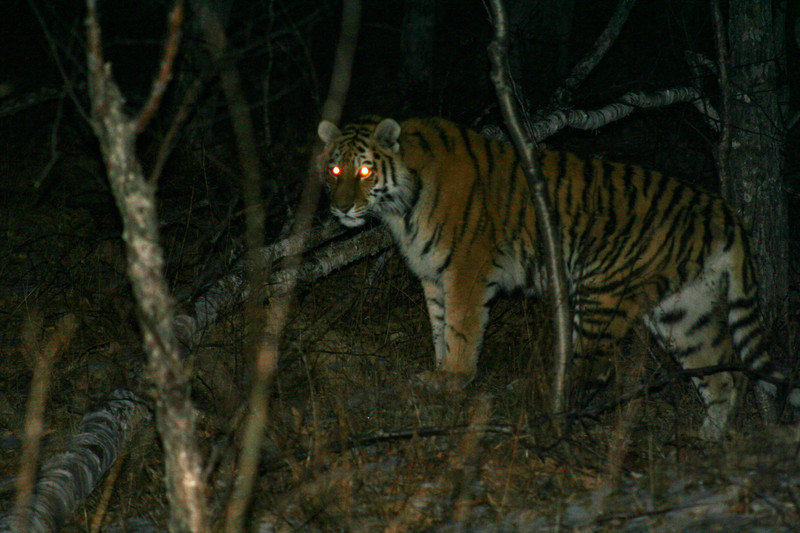 Fascinated, I went home and began combing through local literature and speaking with my colleagues on the subject. There were numerous reports of tigers preying on both brown bears and Asiatic black bears, but the relationship, it seems, was not that simple; there were also reports of bears killing tigers. As the years progressed and we tracked both bears and tigers, the picture of a complex relationship emerged. The largest brown bears — and we recorded bears with weights up to 800 lbs in the area — would usurp kills from tigers and even track them from kill to kill (meeting those bears when searching for tiger kills is another story for another day!). In one case, tracks in the snow told the story of a tigress and bear reluctantly sharing a red deer the tigress had killed. The tracks suggested some bluffing and blustering on the part of both species, but no actual fighting. Rather, it seemed when the tiger had eaten its fill for the day, the bear was able to scare it off, but when the tigress returned hungry and the bear’s stomach was full, the bear would yield to the cat. Once, my colleague Ivan came home from tracking a tigress and told the story of how it spent the better part of a day trying unsuccessfully to pull a black bear with cubs from her winter den.  Dima killed several more bears in the following years that we tracked him, and not all kills were so clean and efficient as my first discovery. At the site of his next kill, another female brown bear, I found a gruesome scene with a huge swath of flattened vegetation where the bear fought for its life. Small trees had been bitten in half, and those that remained standing were splattered with blood. After the fight, Dima spent four days in the area and completely consumed the bear. Why did Dima take such risks? Bears are among the most powerful animals I know, with formidable teeth and claws. Wouldn’t sticking to red deer and sika deer make more sense? While we will never know for sure, I suspect his predation on bears served another purpose than just filling his belly. Likely, he was taking out the competition — the same animals that might kill his cubs or steal the kills of one of the three tigresses with which he shared his territory. 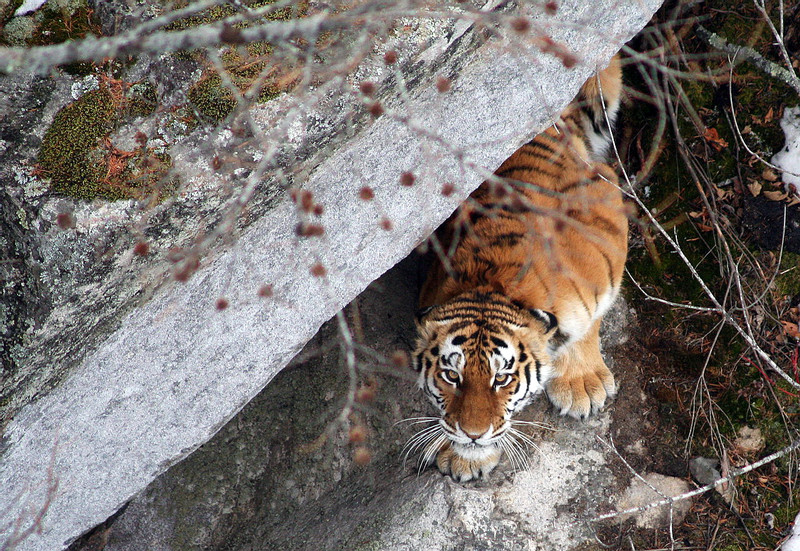 Understanding these types of relationships is important to conservation. For example, if we are working to recover tigers, what are the implications of bears taking their kills (reduced energy intake might mean lower survival of tigers and their cubs)? What impacts will tigers have on bear (and wolf) populations? Amur tigers have recovered from an estimated 40 individuals in the wild about 75 years ago to an estimated 400 today. But during that time, for instance, the local wolf population has plummeted, likely due to displacement and predation by tigers. We don’t want another species to go extinct due to our recovering tigers. While this has not been a concern because both wolves and bears are widely distributed across Eurasia, it is a concern in the southern region where the world’s remaining 40 or so Amur leopards overlap with tigers. Indeed, during our work there, a tiger did kill a leopard. Research in India has shown potentially significant impacts of tigers on leopard abundance and behavior, and that will be the subject of a future blog post. But in the snowy forests of Asia, far at the northern edge of the tiger's range, I saw firsthand the dance between two massive predators — bears and tigers. It was a dance that resulted in death, food, struggle — and for me, insight. Now, I could better understand what it means to protect not only tigers, but all animals. panthera.org/blog-post/dance-death-tigers-and-bears-battle-northeast-asia
|
|
|
|
Post by Gorilla king on May 27, 2022 11:20:29 GMT -5
Reply #362:
Of course we already know that "Dima" is Dale/Misha (M20).
A nice ambush, congratulations.
So the top "Apex predator" tiger gets killed and eaten by brown bears. Awesome.
So an adult female brown bear gave an adult male tiger a good fight, awesome.
See? Its the bears that affect the tiger population and not the other way around. Too many brown bears in the RFE.
I love this report.
|
|
|
|
Post by oldcyansilverback on May 28, 2022 8:15:55 GMT -5
It also shows that 1320 pound and 1000 pound male Ussuri brown bears are rare since not many articles mention them.
|
|
|
|
Post by arctozilla on May 28, 2022 8:31:24 GMT -5
/\ exactly. Tiger fantards always exaggerate tiger's prey weight.
|
|
|
|
Post by Montezuma on May 28, 2022 21:06:33 GMT -5
Reply#362, thats a very good account oldcyansilverback. Who found that?? I have heard that tigers do not shape the brown bear and sloth bear activities but it is very interesting to see that instead the brown bear effect the tiger's survival rate, showing brown bear's dominance. The statement of 800pound male brown bear displacing tigers from their kills is also a great new account for kleptopatasitism. The book Bears of the world: Management and Conservation tells that brown bear kleptoparasitism determines the diet intake of large and small felines, meaning brown bears through kelptoparasitism effect the all big cat's activity. Just want to add that many people agrue that tigers kill more bears than vice versa showing tiger's dominance. Thats wrong. In North America, cougars have killed more wolves than vice versa but generally, the cougars always gets dominated by the wolves especially on kill disputes showing that wolves dominate cougars. Similarly, the tiger kill more brown bears and brown bears does, but the tiger of every size or age or gender gets dominated. Anyways, the diet chart from TSTP, shows that bears especially brown bears, are basically not on tiger's menu. Mostly, its only exaggration. |
|
|
|
Post by arctozilla on May 29, 2022 16:12:41 GMT -5
/\ Tigers kill more bears than viceversa because they target young individuals and females while they avoid adult males. Here's why
|
|
|
|
Post by brobear on May 30, 2022 3:59:53 GMT -5
/\ Tigers kill more bears because they target young individuals and females while they avoid adult males. Here's why The oldest male brown bear thus far confirmed ambushed and killed by a tiger was an adolescent five year old. |
|
|
|
Post by Montezuma on May 30, 2022 21:06:59 GMT -5
/\ Tigers kill more bears because they target young individuals and females while they avoid adult males. Here's why Tigers take all these bears in ambush or during the bear hibernation while bears take down tigers in fights. Even the youngs and female bears are very rarely hunted, especially brown bear. The Siberian tiger project's tiger diet table showed that brown bears were basically zero in most decades and in most important areas meaning even female brown bears and young specimens do not worry about tigers since tigers generally do not see them as prey. Saying that tiger regularly prey on bears, is no more than fantansy since the diet chart basically and easily debuncks this shit claim. The adult male remains untouched and strictly avoided. Oh yes, and remember what the Amurtiger centre said on instagram that "tigers are not interested in bear meat". |
|
|
|
Post by Montezuma on May 30, 2022 21:32:14 GMT -5
I am just adding this #16 point too in this post:-
beargorillarealm.proboards.com/post/5223
16#. Brown bear kleptoparasitism can shape tiger's prey selection meaning brown bears can also effect tiger's survival rate. (Krofel, John Goldrich)
|
|
|
|
Post by oldcyansilverback on May 31, 2022 5:56:49 GMT -5
|
|
|
|
Post by Gorilla king on May 31, 2022 10:20:05 GMT -5
Yeah, we dont know Chamlid's age, so another possibility is that it was a bear well past its prime, like a 20-25 year old bear, so maybe it was still strong enough to displace a tigress without a fight, but not strong enough to fight an adult male tiger. If this bear was very old, and the tiger did kill him, then this would mean a tiger killed an old, past its prime, adult male brown bear, most likely by ambush as there is no description of a fight, and even if there was a description of a fight, it could have still started by ambush and the bear was already injured by that initial ambush. All this is just speculation of course. So if all this was to be true, we would still have no confirmed case of a tiger killing an adult male brown bear in its prime, and much less face to face. Anyhow, we know this case is not confirmed.
|
|
|
|
Post by brobear on May 31, 2022 12:46:11 GMT -5
There is, in reality, absolutely no evidence that Chamlid was killed by a tiger and no solid reason for anyone think so. Is it possible for a healthy male tiger, in his prime, to ambush and kill an elderly male brown bear? Theoretically yes, although we have no confirmed case of it ever happening; not even with a shatunn. What we do know for certain; Desperate tiger fanboys grasp at every straw and are quick to jump to conclusions that favor their chosen favorite. *Note; the idea of a male tiger seeking vengeance on a bear for displacing his "girlfriend" from her kills is absurd.  |
|
|
|
Post by oldcyansilverback on Jun 4, 2022 7:02:42 GMT -5
Reply 366. I found this article on wildfact.
|
|
|
|
Post by Montezuma on Jun 4, 2022 9:47:06 GMT -5
|
|
|
|
Post by oldcyansilverback on Jun 5, 2022 4:35:48 GMT -5
/\Warsaw 2018 is included in the article. Interesting as he has not posted in a while.
|
|
|
|
Post by arctozilla on Jun 5, 2022 5:32:17 GMT -5
Is Warsaw a biologist now?
|
|
|
|
Post by oldcyansilverback on Jun 5, 2022 5:46:20 GMT -5
Is Warsaw a biologist now? I have no idea. He has not posted for a long time. |
|
|
|
Post by oldcyansilverback on Jun 5, 2022 5:51:50 GMT -5
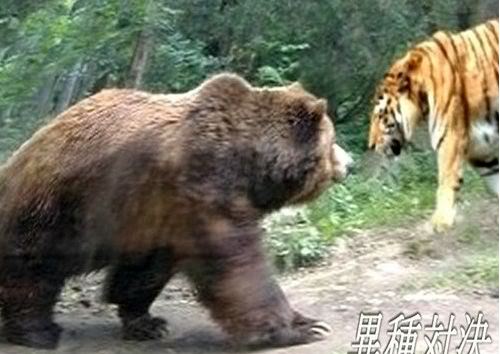 Another interesting visual comparision between the two. Found this picture on google. Does anyone have the video of this? |
|